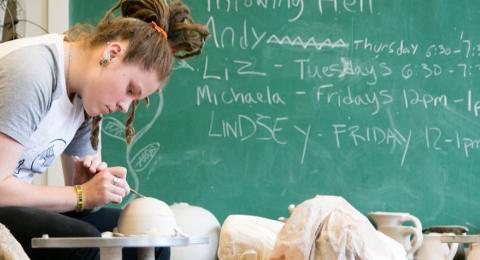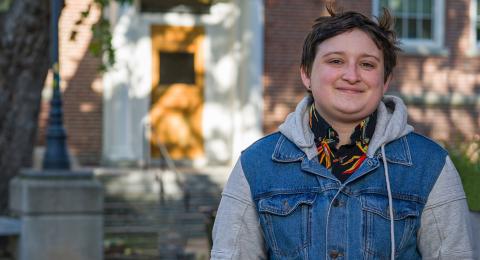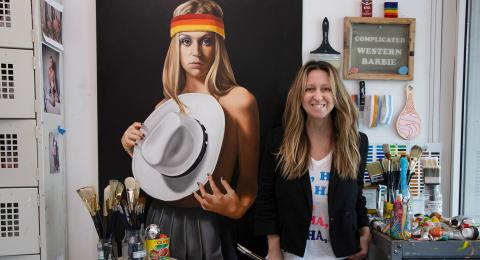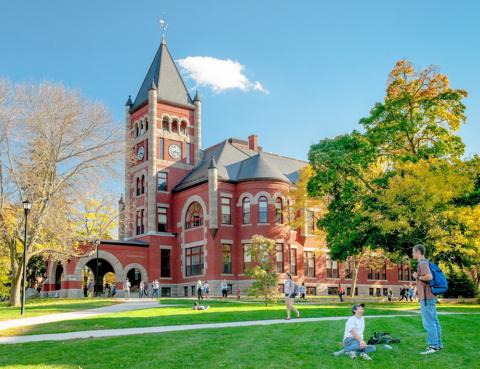The Studio Art major at UNH offers a comprehensive education in two- and three-dimensional art forms, including drawing, painting, ceramics, photography, sculpture and more. Alongside studio practice, students build a strong liberal arts foundation through studying art history, writing, and language, preparing them for diverse careers or further education in fields like architecture, business, or law. The program is enriched by the Paul Creative Arts Center, the nearby arts community in Portsmouth, and Boston's fine art museums. Students also engage with global artists and historians through the Visiting Artists & Art Historians program.
What is studio art?
Immerse yourself in the fine arts through the studio art major at UNH. You’ll have the opportunity to develop your skills practicing two- and three-dimensional art forms that range from drawing, painting and photography to ceramics, sculpture and furniture design. You’ll gain a wide breadth of studio experience while also studying art history, writing and language to build a solid foundation in the liberal arts. With a degree in studio art, you’ll be prepared for careers in the arts or further study in graduate programs as varied as architecture, business and law.
Why study studio art at UNH?
With the UNH Gallery of Art and Paul Creative Arts Center right on campus, the culturally rich community of Portsmouth just minutes away, and the fine art museums of Boston within an hour’s drive, you’ll be surrounded by dynamic art events and exhibits. You’ll meet and learn from artists and historians from around the world through our Visiting Artists & Art Historians program. A double major in studio art and art history also is available.
Potential careers
- Art teacher
- Commercial artist
- Designer
- Gallery director
- Illustrator
- Museum director
- Photographer
- Professional artist
- Visual resource librarian
Curriculum & Requirements
The B.A. in art - studio art option provides a strong fine arts education and solid foundation that prepares students for a life in the arts, whether it be as a professional or commercial artist, a teacher, an architect, a designer or a museum director. We offer courses in painting, drawing, photography (both digital and wet lab techniques), printmaking, sculpture (all media: steel, aluminum, bronze casting, clay, and wood), furniture design and fabrication, ceramics and design. A degree in studio art provides a foundation for diverse professional achievement.
Degree Requirements
All Major, Option and Elective Requirements as indicated.
*Major GPA requirements as indicated.
Major Requirements
- Students must complete a minimum of 14 courses (56 credits) for the major requirements.
- Major courses must be completed with a minimum grade of C in each course. The required minimum overall GPA in major coursework is 2.0.
- Studio art majors may use two major-required courses to satisfy two Discovery category requirements.
| Code | Title | Credits |
|---|---|---|
| Required Courses | ||
| Core Foundation | ||
| ARTS 510 | Principles of Design | 4 |
| ARTS 532 | Introductory Drawing | 4 |
| ARTS 567 | Introductory Sculpture | 4 |
| Core Supplemental | ||
| Select one 500/600-level 2D course from the following: | 4 | |
ARTS 536 | Introduction Printmaking: Intaglio | |
ARTS 546 | Painting Design I: Perceptual Painting and Color Theory | |
ARTS 640 | Drawing Workshop | |
| Select one 500-level 3D course from the following: | 4 | |
ARTS 501 | Introductory Ceramics | |
ARTS 525 | Introductory Woodworking | |
| Select one 500-level Photography course from the following: | 4 | |
ARTS 551 | Introduction to Darkroom Photography | |
ARTS 552 | Introductory Digital Photography | |
| Concentration Courses | ||
| Select four (4) Studio courses in a concentration at 500-600-700 level (see concentration courses below) | 16 | |
| Advanced Studio Seminar | ||
| ARTS 780 | Advanced Studio Seminar | 4 |
| Core Art History | ||
| Select one course from the following: | 4 | |
ARTH 474 | Introduction to Architectural History | |
or ARTH 480 | Introduction to Art History | |
or ARTH 485 | Introduction to Global Art History | |
| Select two 600-level or above art history courses from the following: | 8 | |
ARTH 674 | Greek Art and Architecture | |
ARTH 678 | Romanesque and Gothic Art | |
ARTH 681 | Early Renaissance Art | |
ARTH 682 | The High Renaissance | |
ARTH 686 | Sex and Sensuality in 18th-Century Art | |
ARTH 688 | Histories of Late 19th & 20th Century European Modernism | |
ARTH 694 | Vision and Modernity: From Panorama to Early Film | |
ARTH 695 | Topics in Art History | |
ARTH 795 | Understanding Art History: An In-Depth Overview | |
| Total Credits | 56 | |
Concentration Courses
- Students select four concentration courses total.
- Minimum of three 600-700 level studio courses.
- No more than one of the following: a 500-level studio course (select from ARTS 501 , ARTS 525, ARTS 536, ARTS 546, ARTS 551, ARTS 552, ARTS 596), ARTS 598 An Artist's Life, a 600-700 level art history (see selection of courses in art history requirement above), or ARTS 600 Internship in Studio Art (with approval).
- January Term and Summer online courses cannot be used.
| Code | Title | Credits |
|---|---|---|
ARTS 601 | Ceramics Workshop (may be repeated) | |
ARTS 610 | Principles of Typography | |
ARTS 611 | Animation and Motion Design | |
ARTS 612 | Interaction & Game Design | |
ARTS 613 | Design and Place | |
ARTS 614 | Design and People | |
ARTS 625 | Wood/Furniture Design Workshop (may be repeated) | |
ARTS 636 | Printmaking Workshop (may be repeated) | |
ARTS 640 | Drawing Workshop | |
ARTS 651 | Photography Workshop (may be repeated) | |
ARTS 660 | Painting Workshop | |
ARTS 667 | Sculpture Workshop (may be repeated) | |
ARTS 796 | Independent Study: Studio Art (K: Wood Design, may be repeated) |
While these courses represent the minimum departmental requirements for the studio art option, students may wish to plan a program involving greater depth in one or several of the studio areas.
Capstone
The Discovery Program capstone requirement will be fulfilled by completing a capstone project that reflects the training received, and personal artistic growth made, throughout the student’s years of study at UNH. The capstone project includes participation in the BA/BFA Senior Exhibition in the UNH Museum of Art in April-May. Students will submit a minimum of 5 (or the equivalent what would be the equivalent of 5) recent works for faculty to review and select for the exhibition. At the review a written artist statement and verbal explanation of the work must also be presented.
Candidates for a degree must satisfy all of the University Discovery Program requirements in addition to satisfying the requirements of each individual major program. Bachelor of arts candidates must also satisfy the foreign language proficiency requirement.
Program Learning Outcomes
Introductory (500) Level:
- Basic skillset in a particular arts discipline
- Working knowledge of the tools and materials used in a particular arts discipline
- Basic understanding of analytical thinking when making and talking about art
- Demonstrate development of artistry
Intermediate (500/600) Level:
- Demonstrate development of artistry and skill set in a range of artistic disciplines
- Demonstrate knowledge of tools and materials beyond the basics
- Deeper ability to discuss and analyze works of art
- Ability to verbalize intent in a particular work of art
- Ability to research particular artists
- Ability to declare an area of concentration for advanced in a particular arts discipline
Advanced (600/700) Level:
- Demonstrate a high level of artistry
- Ability to work independently
- Develop and Demonstrate an individual sensibility
- Ability to understand and verbalize intent in a work of art
- Ability to construct a professional capstone portfolio or thesis
- Demonstrate in-depth familiarity with a range of artistic movements both historical and contemporary
Explore Program Details
The two-dimensional curriculum is the largest in the department, and its breadth and content are shaped by the variety of approaches and expertise of the faculty. The 2-D courses are based on solid basic training and on the encouragement of independent and personal expression. Figuration and still life drawing are the core of the program. After completing Introductory Drawing, students pursue a wide variety of course offerings, choosing from oil painting, water media, photography, printmaking, and advanced drawing. Students work in classroom studios and participate in group critiques and seminars. Towards the end of the four year curriculum, individual works receive increasingly detailed review and critique. Students are taught to methodically evaluate their own and other students work.
North light and clerestory windows for even light distribution throughout the day illuminate the large, open studios. Class size varies, and upper level studio enrollment is usually about 15 students per class. Easels, drawing benches, and models are provided. Student works are exhibited in the corridors of the art wing of the Paul Creative Arts Center.
The three-dimensional curriculum offers concentrations in sculpture, ceramics, woodworking, and furniture design. While each of these programs has a distinct curriculum, together they interrelate to form a comprehensive area. Teaching is highly individualized, enabling students to understand and develop their own styles while learning the aesthetic principles and technical skills involved in class projects. Assignments are based on contemporary issues but always develop from a sound historical perspective. Class size is kept small to provide structured, personal instruction. Full time technical assistants and student fellows who provide further instruction and technical help outside of class assist professors.
The sculpture studio offers a complete bronze foundry, fabrication tools, equipment for work in wood and metal, gas and electric welding, a carving facility for wood and stone, hand and pneumatic tools, and a figure modeling area which provides quality space and light for anatomic modeling.
The ceramics studio offers opportunities for hand building, mold making, and wheel thrown work. Both utilitarian and sculptural aspects are explored. The studios are equipped with kickwheels, gas, electric and raku kilns.
The woodworking and furniture design studio has a well equipped shop in which the broadest range of techniques is pursued. A full complement of hand and power tools is augmented by facilities for clamping and gluing, bending, forming, and finishing wood. The furniture program includes Arts 725 Wood Multiples, which prepares students to enter such events as the biennial National Students Furniture Design Competition. UNH has had several prizewinners in recent years.
The University offers an approved art education program that is organized into a five-year teacher education sequence. This curriculum is designed to prepare teachers of art in the public schools. The satisfactory completion of the B.A. Studio Art curriculum for art education students (note: which differs slightly from the B.A. Studio Art curriculum) and required education courses, in conjunction with the fifth-year internship, will satisfy the initial certification requirements for teachers of art in the public schools of New Hampshire and in most other states. Art education students may take accredited crafts courses at other institutions as art electives. Students considering the art education program should consult the UNH Undergraduate Catalog under the heading "Preparing for Teaching."
Students can elect to receive a B.A. in the Arts with both the Studio Art option and the Art History option. Students must complete the requirements for both options; no more than 8 credits used to satisfy one option can be used as requirements for the other option. Please contact your advisor for more information.








